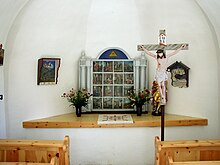Briccius Chapel (Heiligenblut)
The Briccius Chapel is a chapel in the upper Mölltal near Heiligenblut am Großglockner in Carinthia , Austria . It is located at 1629 m above sea level above the herb wall on the Sattelalpe on the Alpenblumensteig, which leads from Heiligenblut to the Glocknerhaus .
history
A Briccius chapel is first mentioned in 1271, but the current building dates from 1872.
features
The small rectangular building with a 3/8 end has a stitch cap vault. The baroque altarpiece shows 16 representations from the Briccius legend (see below).
The legend of Briccius
According to legend, the Danish prince Briccius was killed by an avalanche in 914 on the site of today's Briccius Chapel while attempting to cross the Alps . He carried an ampoule with the blood of Jesus Christ , which is said to have flowed from an image of the crucified Christ in the Church of St. Sophia in Constantinople . At Christmas 914 farmers found three green ears of wheat in the snow while pulling hay near the current Briccius Chapel. They then discovered the prince's body and the ampoule with the blood that has been kept in the church of Heiligenblut ever since .
Scientific interpretation of the legend
There is no evidence that Saint Briccius really lived. But the name is the Latin version of Friedrich. This is the name of several bishops of Salzburg in the High Middle Ages who at that time owned properties in the upper Mölltal. The Briccius legend may come from this time. It is fitting that only with the introduction of the doctrine of transubstantiation and the feast of Corpus Christi in the 13th century do alleged relics of the Blood of Christ accumulate.
The Briccius Chapel was built over the Briccius spring . Their water is said to have healing properties and especially to help with eye problems. It is therefore reasonable to assume that it was built over a pagan spring shrine and was now dedicated to a Christian saint. In the Middle Ages, this was a very common practice when Christianizing sources.
Individual evidence
- ^ Dehio manual. The art monuments of Austria. Carinthia . Anton Schroll, Vienna 2001, ISBN 3-7031-0712-X , p. 1074.
- ↑ Briccius and Heiligenblut, Sagen.at, on the Internet: http://www.sagen.at/texte/sagen/oesterreich/kaernten/Graber/heiligenblut.html
- ↑ Text panels in an information hut next to the chapel.
- ^ Karl Weinhold: The adoration of sources in Germany, on the Internet: http://www.heilige-quellen.de/Ordner_Wasser_Volkskunde/Weinhold_Verehrung_d_Quellen_Seite.html
Coordinates: 47 ° 3 ′ 19.1 ″ N , 12 ° 47 ′ 22.7 ″ E


